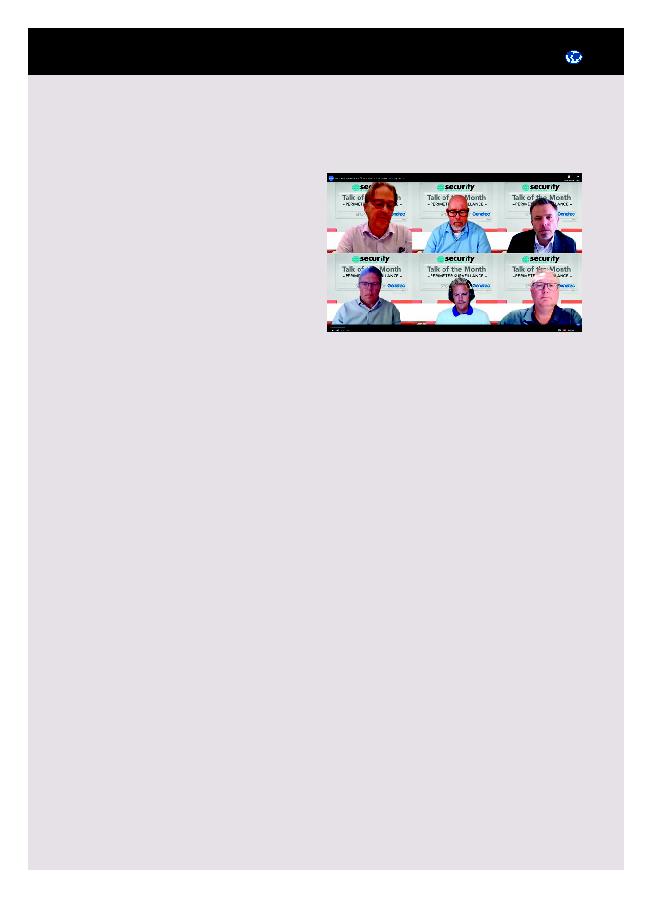
d e t e k t o r i n t e r n a t i o n a l · 1 1
Security News Every Day www.securityworldmarket.com
Industry people in a panel discussion
about perimeter security technology
The participants in the panel discus-
sion were all representing compa-
nies with a strong connection to
perimeter surveillance.
· Mark Cosgrave
, Divisional Di-
rector of Optex Security EMEA.
· Sonny Hardarsson
, Sales Engi-
neer at Axis Communications.
· Robert Jansson
, Director of Sales
for Nordics, Eastern Europe and
South Africa at Stid Security.
· Erik Nord
, Business Develop-
ment Manager at Genetec.
· Kenneth Nyström
, CEO of the
system distributor Securify, special-
ised in perimeter surveillance.
Here follows a short summary
of the panel discussion, that was
moderated by Detektor´s Editor-in-
chief Lennart Alexandrie.
Commercial applications
Historically, this field of security
is most associated with critical infra-
structure, but demand the demand
is also rising in commercial areas,
which which was the main focus of
discussion.
"Retail is maybe not the first
vertical you come to think of when
discussing perimeter solutions, but
the increase in online shopping has
rapidly put more pressure on the
logistical hubs, and the security for
those," stated Kenneth Nyström,
CEO of Securify, a system dis-
tributor, specialised in perimeter
surveillance.
An important remark was also
made on the changing modus
operandi of the criminals, warrant-
ing the need for more advanced
perimeter solutions.
"Every now and then, there are
smash and grab incidents involving
large vehicles enforcing the walls
and barriers. It's over in a couple of
minutes, driving the need for new
approaches to mitigate this", stated
Kenneth Nyström and pointing to
the need for very early detection.
"I call it beyond the defence
line" he said.
Nuisance Alarms
The problem of nuisance alarms in
security systems for high-security
industrial applications is a critical
issue that was also discussed. This
can lead to unnecessary disrup-
tions, wasted resources, and even
compromise of the security system
itself. Nuisance alarms seem to be
more related to how installations
are conducted than a technology
problem. But how should an end-
user know which supplier to choose
when looking for an advanced
perimeter surveillance solution that
detects intrusions and ignores natu-
ral changes in the perimeter?
"There is nothing wrong with
asking questions! Be a bit of a
sleuth, be like Sherlock Hol-
mes" was the recommendation to
end-users, put forward by Mark
Cosgrave from Optex.
The industry panelists were also
agreeing that all players in the de-
livery chain probably could step up
their efforts; end-users included.
Erik Nord from Genetec was
further stressing the importance of
consultants, but also the role of cer-
tifications and the partner-network
managed by the leading security
brands. Among the panelists there
was also a consensus concerning the
importance of continuous training
among installers.
Different technologies
Perimeter surveillance has always
been a tough task for the security
industry, but the panelists pointed
to numerous technological develop-
ments that have served to develop
perimeter protection in past years.
An example is Lidar technology,
which uses laser light to measure
distances.
"By installing Lidar sensors
along a perimeter, the technology
can detect any objects or people
that cross it and create a detailed
3D map of the surroundings", said
Mark Cosgrave.
Additionally, radar technol-
ogy also used for object detection
can operate in adverse weather
conditions and can detect threats at
a longer range compared to other
technologies.
"The combination of object
detection technologies, for example
radar, cameras and analytics, offer
value in a broad range of use cases
and applications," said Sonny Hard-
arsson from Axis Communications.
It also became clear that im-
provements in user experience and
usability is findings its way into the
perimeter surveillance mix.
"It has become a lot easier to set
up analytics for the basic demands,
fence-line detection for example.
It is virtually effortless to set up to-
day", said Erik Nord from Genetec.
Access control perspective
Robert Jansson, representing the ac-
cess control dimension of perimeter
protection, was asked to point out
the advancements being made in
his area of expertise.
"Two-factor authentication is
coming to vehicles now. License-
plate recognition is a cost-efficient
and convenient method, that could
be combined depending on the
hour with optical authentication
as well as with encrypted UHF to-
kens, said Robert Jansson who also
lifted the need to secure the identity
of the driver.
"Who is driving the car? Two-
factor authentication is coming to
the driver-side of the vehicle now.
And it is coming in a convenient
way, meaning that the driver doesn't
have to leave the seat. This has
exploded over the past two years.
Cloud-Based perimeter
security systems
It is often reported that moving
perimeter security systems to the
cloud can offer numerous benefits,
including increased scalability, flex-
ibility, and cost-effectiveness.
However, there are also risks
associated with moving physical
security systems to the cloud. One
such significant risk is the potential
for service outages or disruptions,
which can leave organisations
vulnerable to security breaches dur-
ing periods when the cloud-based
system is unavailable. Additionally,
there is a regulatory risk especially
with the updated and various data
protection acts coming into force in
recent years.
Given the tailored solutions
often required for perimeter surveil-
lance, it is difficult to work with
a standard solution, according to
Kenneth Nyström.
"There are no silver bullets" he
stated clearly and stated that "not
every end-user is prepared to send
data to the cloud".
By Lennart Alexandrie
The online panel: Lennart Alexandrie (moderator), Kenneth Nyström, Securify, Mark
Cosgrave, Optex, Sonny Hardarsson, Axis, Erik Nord, Genetec and Robert Jansson,
Stid.
In a recent video panel discussion, organised by
Securityworldmarket.com, a highly experienced
panel of participants shared their insights regard-
ing the current state and the future of perimeter
surveillance.
Special Feature: Perimeter Surveillance
Editor: Lennart Alexandrie

